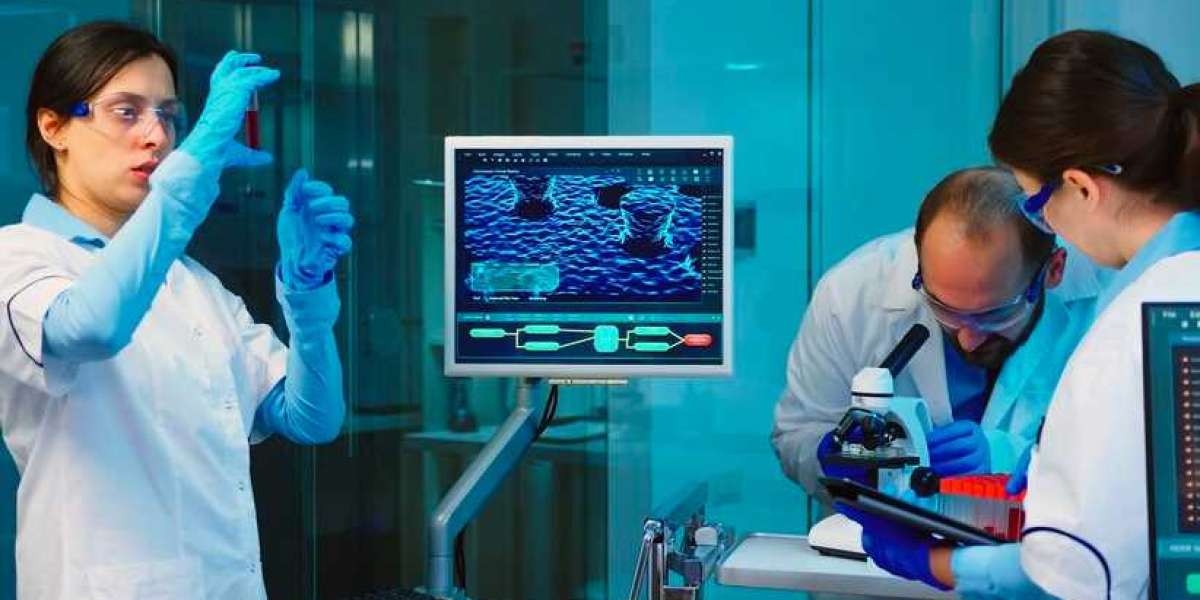The landscape of disease detection and diagnostics has witnessed a revolutionary transformation with the advent of biosensors.
These advanced devices have emerged as powerful tools for rapid and accurate identification of various diseases, offering unparalleled efficiency and precision.
This article explores the world of biosensors and diagnostics, delving into their mechanisms, applications, and the impact they have on healthcare.
Understanding Biosensors
A Paradigm Shift in Disease Detection
Biosensors represent a paradigm shift in disease detection methodologies. These devices integrate biological components with cutting-edge sensor technologies to detect specific biological markers indicative of various diseases. The marriage of biology and technology has paved the way for rapid, sensitive, and cost-effective diagnostic solutions.
Mechanisms and Types of Biosensors
Fundamental Operating Mechanisms
Transduction Processes
At the core of biosensors are transduction processes that convert biological responses into measurable signals. Common transduction mechanisms include optical, electrochemical, and piezoelectric processes, each offering distinct advantages in terms of sensitivity and real-time detection.
Categories of Biosensors
Enzyme-Based Biosensors
Enzyme-based biosensors leverage the specificity of enzymes to detect target analytes. The interaction between the enzyme and the analyte produces a measurable signal, enabling the identification of specific diseases with high accuracy.
DNA-Based Biosensors
DNA-based biosensors utilize the unique binding properties of DNA to identify genetic sequences associated with diseases. These biosensors are instrumental in genetic diagnostics, offering insights into inherited conditions and predispositions.
Optical Biosensors
Optical biosensors rely on the interaction between light and biological molecules. Surface plasmon resonance and fluorescence are common optical techniques employed in biosensors, providing real-time and label-free detection of diseases.
Applications of Biosensors in Disease Detection
Infectious Disease Diagnostics
Rapid Detection of Pathogens
Biosensors have transformed the landscape of infectious disease diagnostics by enabling the rapid and specific detection of pathogens. From viruses to bacteria, biosensors play a crucial role in identifying infectious agents and facilitating prompt interventions.
Cancer Biomarker Detection
Early Cancer Diagnosis
In the realm of oncology, biosensors contribute to early cancer diagnosis by detecting specific biomarkers associated with different types of cancer. This early identification enhances the chances of successful treatment and improved patient outcomes.
Diabetes Monitoring
Continuous Glucose Monitoring
For individuals with diabetes, biosensors offer continuous glucose monitoring, eliminating the need for frequent blood tests. This real-time data enables better management of blood sugar levels and enhances overall diabetes care.
Advancements in Biosensor Technologies
Nanotechnology Integration
Nanomaterials for Enhanced Sensitivity
The integration of nanotechnology into biosensors has significantly enhanced their sensitivity and specificity. Nanomaterials, such as nanoparticles and nanowires, provide increased surface areas and improved interactions with biological molecules, leading to more accurate detection.
Smartphone-Based Biosensors
Point-of-Care Diagnostics
The development of smartphone-based biosensors brings diagnostics to the point of care. These portable devices, equipped with biosensing capabilities, enable rapid testing and immediate results, particularly in resource-limited settings.
Challenges and Considerations in Biosensor Implementation
Standardization and Validation
Ensuring Reliability and Accuracy
The standardization and validation of biosensor technologies pose challenges in ensuring their reliability and accuracy. Establishing rigorous testing protocols and quality control measures is essential to gain widespread acceptance in clinical settings.
Cost and Accessibility
Balancing Affordability and Innovation
While biosensors offer groundbreaking diagnostic capabilities, addressing cost concerns is crucial for widespread adoption. Striking a balance between affordability and innovation is imperative to ensure accessibility to biosensor-based diagnostics, especially in diverse healthcare settings.
Limitations of Biosensors in Disease Detection
Sensitivity and Specificity Challenges
Balancing Sensitivity and Selectivity
One of the key limitations of biosensors in disease detection lies in achieving a delicate balance between sensitivity and specificity. Sensitivity refers to the ability of the biosensor to detect low concentrations of a target molecule, while specificity denotes its ability to distinguish the target from similar molecules. Striking the right balance is challenging and can impact the accuracy of diagnostic results.
Variability in Sample Conditions
Influence of Environmental Factors
Biosensor performance can be influenced by variations in sample conditions. Factors such as temperature, humidity, and pH levels may introduce variability in the results. Ensuring the stability of biosensor performance across diverse environmental conditions is a significant challenge in deploying these devices for disease detection.
Complexity of Biological Matrices
Addressing Matrix Interference
Biological samples used in disease detection often contain complex matrices, including blood, saliva, or urine. The presence of various biomolecules in these matrices can interfere with the biosensor's ability to accurately detect the target analyte. Overcoming matrix interference is an ongoing challenge that requires innovative strategies in biosensor design and optimization.
Limited Multiplexing Capability
Simultaneous Detection of Multiple Analytes
While biosensors excel at detecting specific biomarkers, their capacity for multiplexing—simultaneously detecting multiple analytes—is limited. In complex diseases where multiple biomarkers may be relevant, the inability to conduct comprehensive multiplexed analyses can constrain the diagnostic potential of biosensors.
Standardization and Reproducibility
Establishing Consistent Performance
Achieving standardization and reproducibility across different biosensor platforms is a significant limitation.
Variability in manufacturing processes, materials, and operating conditions can impact the consistency of biosensor performance.
Establishing rigorous standards and quality control measures is essential to address these challenges.
Cost Considerations
Balancing Affordability and Accessibility
The cost of biosensor technologies poses a limitation in terms of their widespread adoption.
Developing and producing biosensors with the required sensitivity and specificity can be resource-intensive, impacting affordability.
Balancing the cost of biosensors to ensure accessibility, especially in resource-limited settings, is a critical consideration.
Regulatory Approval and Standardization
Navigating Regulatory Pathways
Navigating regulatory approval processes and achieving standardization in biosensor technologies pose significant challenges. Compliance with regulatory requirements and demonstrating the clinical validity and reliability of biosensors are essential steps in gaining acceptance in clinical settings. Overcoming these hurdles is crucial for the successful integration of biosensors into routine disease detection protocols.
User-Friendly Interface and Integration
Ensuring Practical Implementation
The user-friendliness of biosensors is a crucial factor in their practical implementation in healthcare settings. Ensuring ease of use, interpretation of results, and seamless integration into existing diagnostic workflows is challenging. Developing biosensors with intuitive interfaces that align with healthcare professionals' needs is essential for their successful adoption.
Future Directions in Overcoming Limitations
Advances in Nanotechnology
Enhancing Sensitivity and Specificity
Advances in nanotechnology hold promise for overcoming sensitivity and specificity challenges. Nanomaterials, such as nanoparticles and nanocomposites, can enhance the surface properties of biosensors, improving their sensitivity and selectivity. Continued research in nanotechnology is crucial for addressing these fundamental limitations.
Integration with Artificial Intelligence
Augmenting Diagnostic Capabilities
Integrating biosensors with artificial intelligence (AI) offers a potential solution to variability and complexity challenges. AI algorithms can analyze complex biosensor data patterns, improving the interpretation of results and enhancing diagnostic capabilities. This synergistic approach holds promise for advancing the field of biosensor-based disease detection.
Standardization Initiatives
Establishing Global Standards
Global initiatives for standardization are essential for overcoming variability and reproducibility issues.
Collaborative efforts among researchers, industry stakeholders, and regulatory bodies can lead to the establishment of standardized protocols, ensuring consistent biosensor performance across diverse applications and settings.
Multiplexed Biosensor Platforms
Addressing Analyte Complexity
Advancements in biosensor design to facilitate multiplexing capabilities are underway. Developing biosensors capable of simultaneous detection of multiple analytes addresses the complexity of diseases that involve diverse biomarkers.
Multiplexed biosensor platforms have the potential to provide a more comprehensive diagnostic picture.
Cost-Efficient Biosensor Technologies
Innovations in Manufacturing Processes
Innovations in manufacturing processes can contribute to cost-efficient biosensor technologies.
Exploring novel materials, scalable fabrication techniques and efficient production methods are critical for making biosensors more affordable and accessible, particularly in healthcare systems with limited resources.
Financial Considerations and Role of Medical Billing Services
Infrastructure Costs
Investing in Biosensor Technologies
Healthcare providers considering the integration of biosensor technologies must factor in infrastructure costs. The acquisition of biosensor devices, implementation of supporting technologies, and training of healthcare personnel require financial planning and strategic investment.
Leveraging Medical Billing Services in Dallas
Navigating Financial Landscapes
Medical billing services in Dallas play a vital role in navigating the financial landscapes associated with biosensor implementation.
Their expertise in medical billing and reimbursement processes ensures that healthcare providers can optimize financial resources and streamline billing procedures.
Insurance Coverage for Biosensor Diagnostics
Understanding insurance coverage for biosensor diagnostics is paramount.
Medical billing professionals collaborate with insurers to ensure that biosensor-based tests and diagnostics are appropriately covered, facilitating smoother reimbursement processes for healthcare providers.
Future Perspectives and Innovations
Wearable Biosensors
Continuous Health Monitoring
The future of biosensors includes wearable devices that provide continuous health monitoring. These wearable biosensors can track various health parameters in real-time, offering valuable insights for preventive healthcare and personalized medicine.
Artificial Intelligence Integration
Data Analysis and Interpretation
Integrating biosensors with artificial intelligence (AI) enhances data analysis and interpretation. AI algorithms can process complex biosensor data, providing healthcare professionals with actionable insights and facilitating more accurate disease diagnoses.
Customizable Biosensor Platforms
Tailoring Solutions to Healthcare Needs
Customizable biosensor platforms allow healthcare providers to tailor diagnostic solutions to specific healthcare needs. This flexibility ensures that biosensors can address a wide range of diseases and conditions, contributing to personalized and precise healthcare.
Conclusion: Transforming Healthcare with Biosensors
In conclusion, biosensors have emerged as transformative tools in the field of disease detection and diagnostics.
From infectious diseases to cancer and chronic conditions, biosensors offer rapid and accurate solutions that redefine the way healthcare providers approach patient care.
As biosensor technologies continue to advance, addressing challenges, navigating financial landscapes, and leveraging the expertise of medical billing services in Dallas become integral components in ensuring the seamless integration of biosensors into the future of healthcare.
The marriage of biology and technology in biosensors opens new avenues for precise, personalized, and proactive healthcare that holds the promise of improving patient outcomes and revolutionizing medical practice.








